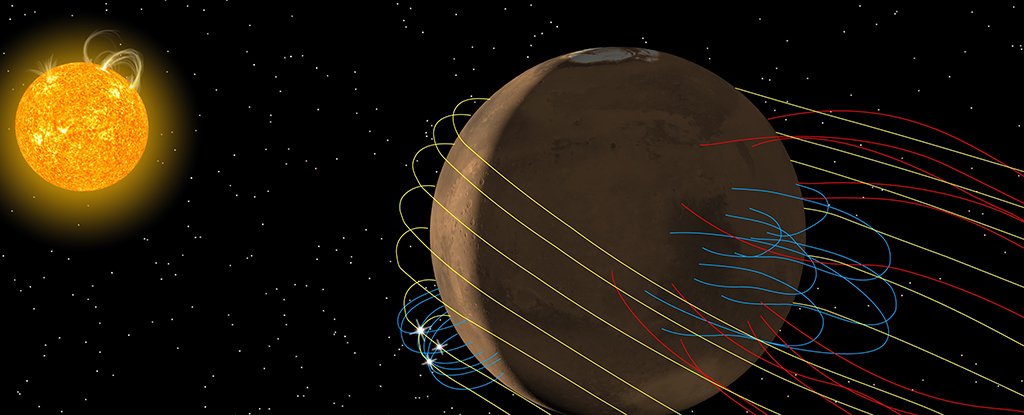 |
| Anil Rao/Univ. of Colorado/MAVEN/NASA GSFC |
NASA has found an invisible,
twisted magnetic tail trailing behind Mars as it orbits the Sun, caused by the
effects of rushing solar winds, and perhaps explaining more about how the
Martian atmosphere escapes into space. This unique insight was revealed by
readings from the Mars Atmosphere and Volatile Evolution Mission (MAVEN)
spacecraft.
Mars Atmosphere and Volatile
Evolution Mission showed how the Red Planet's local magnetic fields behave
differently from the global magnetic field around Earth.
Interactions between
magnetic fields in the Sun's solar winds, and the pockets of magnetism left on
Mars, could give remaining atmospheric particles an escape route out into
space, according to scientists at the NASA Goddard Space Flight Center in
Maryland.
"We found that Mars'
magnetic tail, or magnetotail, is unique in the Solar System," says one of
the team, Gina DiBraccio.
"It's not like the
magnetotail found at Venus, a planet with no magnetic field of its own, nor is
it like Earth's, which is surrounded by its own internally generated magnetic
field. Instead, it is a hybrid between the two."
The solar winds, made up of
electrically conducting gas blown out by the Sun, are thought to have stripped
away much of the Martian atmosphere billions of years ago.
Now, those same winds are
causing the unique magnetotail effect as their combine with the leftover
regions of magnetism still present on certain parts of Mars.
The solar winds carry their
own magnetic fields, and if they hit a region on Mars oriented in the opposite
direction, it causes an effect called magnetic reconnection. It's here that the
invisible twist happens.
"Our model predicted
that magnetic reconnection will cause the Martian magnetotail to twist 45
degrees from what's expected based on the direction of the magnetic field
carried by the solar wind," says DiBraccio.
"When we compared those
predictions to MAVEN data on the directions of the Martian and solar wind
magnetic fields, they were in very good agreement."
That magnetic reconnection
could also be pushing more of the already thin atmosphere on Mars out into
space.
It is pushing it as
electrically charged ions in the planet's upper atmosphere respond to the
magnetic field created by the tail.
The magnetotail essentially
gives these particles a path to follow to flow off the planet, using energy
created by the magnetic reconnection – like a stretched rubber band suddenly
snapping back into place, according to NASA.
MAVEN is continually
changing its orbit in relation to the Sun.
Due to this it's been able
to map the magnetic fields of Mars in their entirety, and build up a map of the
way the magnetotail is sent twisting and fluctuating by the solar winds.
Next, the researchers want
to examine readings from instruments on MAVEN besides the magnetometer to
confirm that reconnected magnetic fields are indeed contributing to atmospheric
loss, and to what extent.
All of which is going to be
vital information if we decide to settle down on the Red Planet in the next few
decades – that lack of atmosphere is one of the main stumbling blocks.
"Mars is really
complicated but really interesting at the same time," says DiBraccio.
The research has been
presented at the annual meeting of the American Astronomical Society's Division
for Planetary Sciences in Utah.
Via Sciencealert


